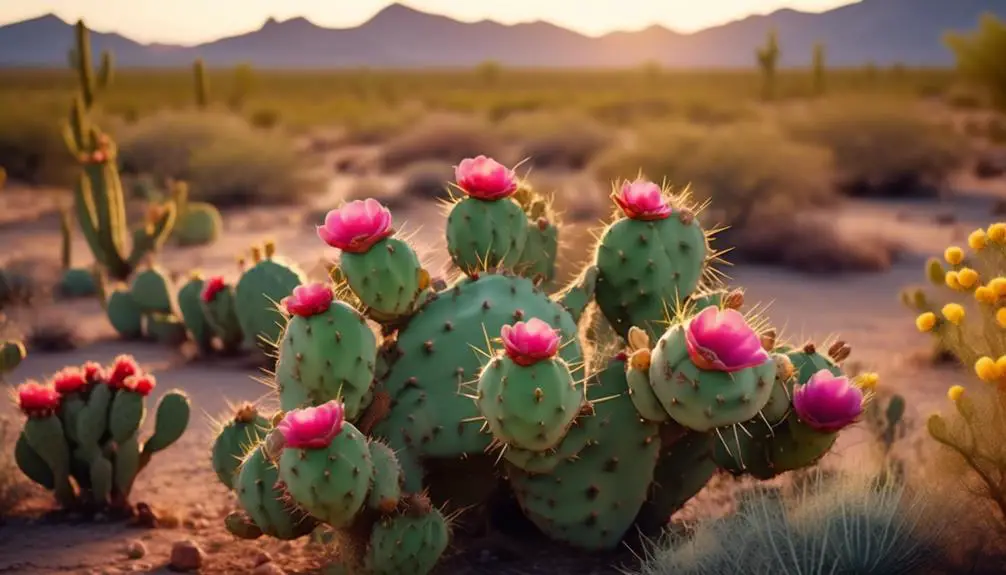In the arid landscapes of Arizona, where the sun beats down relentlessly, there exists a hidden world of culinary possibilities: wild edible plants.
Picture this – the prickly spines of a cactus, juxtaposed against the promise of juicy fruit and tender pads. But that’s just the beginning.
Mesquite, Jojoba, Saguaro, Ironwood, Palo Verde Seeds – all these plants hold secrets, flavors that have been cherished by the native people for centuries.
And there’s more, a tantalizing array of plants to discover.
So, step into this desert treasure trove, where every plant has a story to tell and a taste to savor.
Prickly Pear
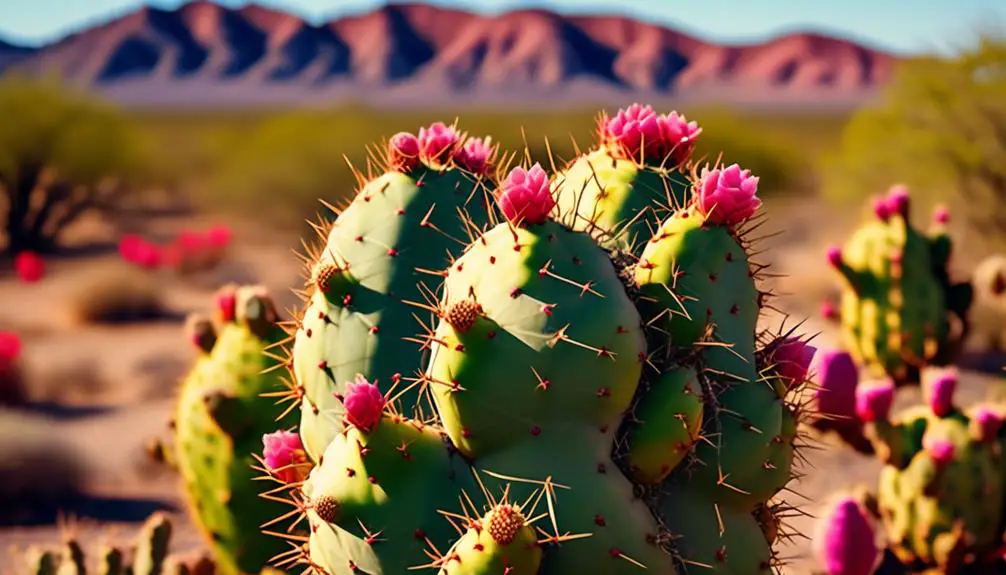
Prickly pear, a versatile and nutritious desert plant, is a signature flavor in Arizona’s culinary scene. Found abundantly in the Sonoran Desert, the prickly pear cactus offers both its pads, known as nopales, and its fruits as edible plants.
In Mexican cuisine, nopales are a popular ingredient, known for their unique texture and slightly tangy flavor. They can be grilled, sautéed, or used in salads, adding a delightful crunch to any dish.
The fruits of the prickly pear can be enjoyed in various ways. They can be eaten fresh, juiced, or made into syrups for use in drinks and desserts. However, before consuming either the pads or the fruits, careful preparation is required to remove the thorns.
Despite the prickly exterior, the prickly pear offers a nutritious and delicious addition to Arizona’s culinary repertoire. Its adaptability and versatility make it a prized ingredient that showcases the rich flavors of the Sonoran Desert.
Mesquite
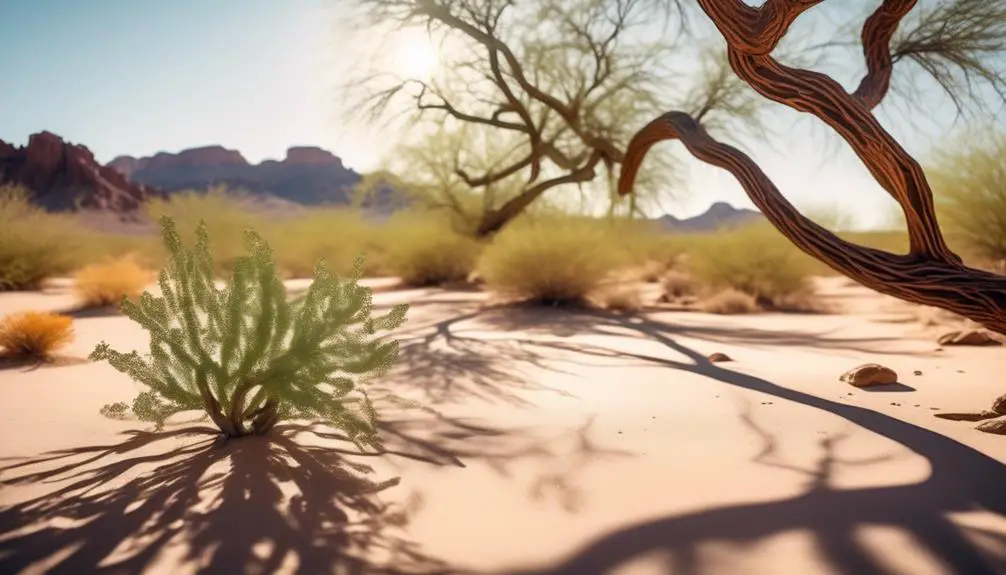
Have you ever wondered about the culinary uses of mesquite, a versatile and flavorful plant found in Arizona? Well, mesquite isn’t just a tree that provides shade in the desert; its pods are actually edible and have been used for centuries by Native Americans as a source of food.
The pods can be ground into a fine flour, which can then be used for baking. This mesquite flour has a unique and spicy taste that’s reminiscent of gingerbread, adding a delightful flavor to your dishes.
Mesquite flour is a popular ingredient in Arizona, where it’s used in various culinary applications. Its distinctive flavor adds depth and complexity to baked goods, giving them a rich and earthy taste.
In addition to its delicious flavor, mesquite flour is also a nutritious choice. It’s high in protein and fiber, making it a great option for those looking to incorporate more nutrients into their diet.
Jojoba

If you’re looking to explore more edible plants in Arizona, let’s now turn our attention to jojoba, a desert plant with versatile uses.
Jojoba is a shrub that grows in the Sonoran Desert, alongside iconic plants like the saguaro cactus and the prickly pear.
This plant is known for its moisturizing properties, and its nuts can be eaten. Jojoba oil, extracted from these nuts, is commonly used in skincare and hair products due to its hydrating and nourishing benefits.
The nuts themselves have a bitter flavor similar to almonds, making them suitable for culinary applications. In fact, they’re often used in cooking and baking to add a unique twist to dishes.
Additionally, the waxy substance produced by the jojoba plant can be used as a natural skin moisturizer. So, not only is jojoba an edible plant, but it also offers various uses in the realm of cosmetics and personal care.
Saguaro
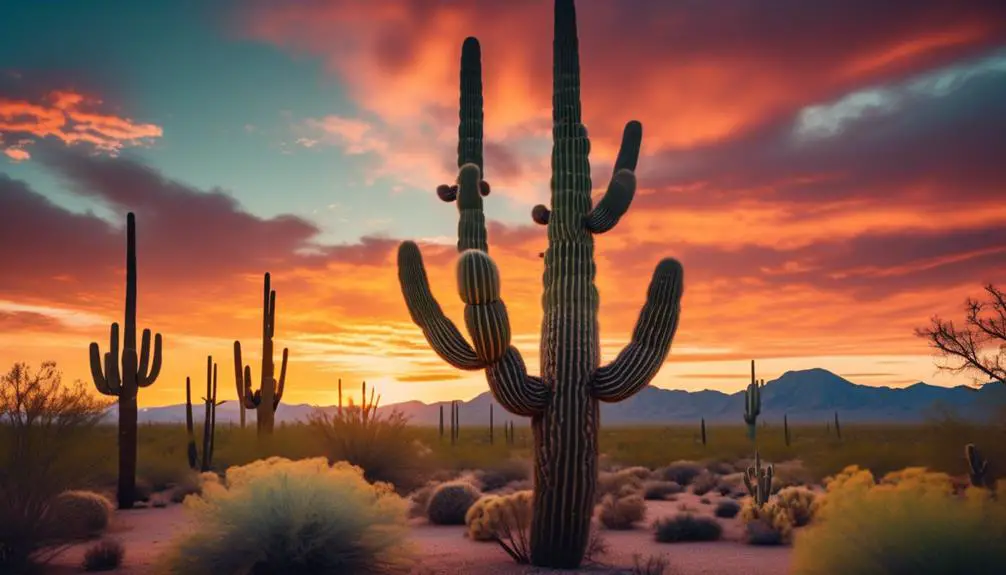
When exploring edible plants in Arizona, one can’t overlook the Saguaro, a towering cactus that stands out in the Sonoran Desert. The Saguaro isn’t only a remarkable sight, but it also offers delicious and nutritious fruit.
The fruit, known as prickly pear fruit, is ruby-colored and ripens by late June. Both the pulp and seeds of the Saguaro are edible and can be enjoyed raw or used in various culinary creations. The sweet pulp can be used to make jams, wines, and syrups, adding a unique flavor to your dishes.
Harvesting the Saguaro fruit can be a bit challenging as it grows on the crowns of the arms and main stalk, but with a long stick, you can easily reach the delicious rewards.
Ironwood
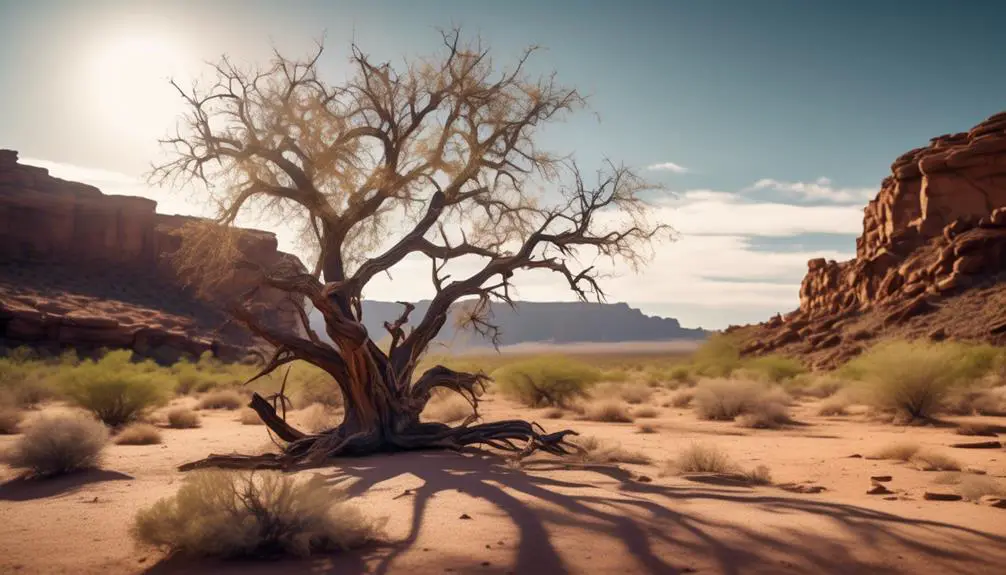
Ironwood trees in Arizona produce seeds that are highly prized for their rich flavor and versatility in culinary applications. Similar to piñon nuts, these seeds are harvested during a two-week period each year. Ironwood seeds can be enjoyed raw, roasted, or ground into a flour for various recipes. Their unique taste makes them a treasured find in the Arizona desert.
When foraging for Ironwood seeds, it’s important to have patience and a keen understanding of the tree’s growth cycle and habitat. These slow-growing trees can be found in arid regions, often growing alongside other desert plants such as saguaro fruit, cholla cactus, and mesquite pods.
To harvest the seeds, you’ll need to wait until they’re fully mature and have fallen to the ground. They can be easily recognized by their small, dark brown shells. Once collected, the seeds can be cracked open to reveal the delicious kernel inside.
Ironwood seeds can be used in a variety of culinary creations. They add a nutty flavor and crunchy texture to salads, baked goods, and even savory dishes. Their versatility makes them a popular choice among Arizona chefs and food enthusiasts.
Next time you find yourself in the Arizona desert, keep an eye out for Ironwood trees and their prized seeds. You won’t be disappointed by their rich and flavorful taste.
Wolfberry
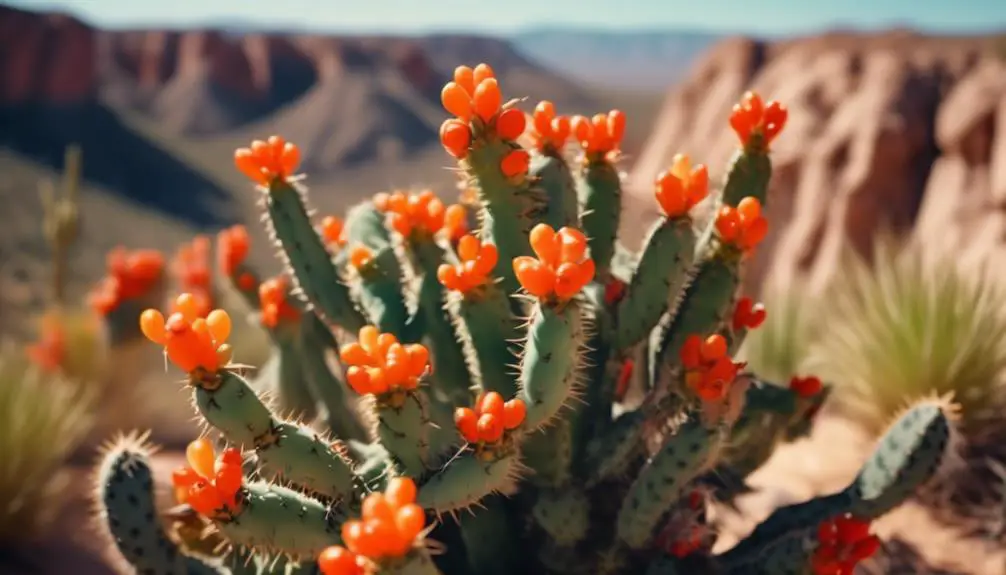
After exploring the delicious and versatile Ironwood seeds, let’s now turn our attention to another edible plant found in the Arizona desert: the Wolfberry. Also known as goji berries, these small red fruits can be found on large bushes in the Sonoran Desert. One important thing to note is that it’s crucial to correctly identify wolfberries before consuming them, as there are poisonous options that resemble them.
The great thing about wolfberries is that they can be eaten directly from the bush without any special preparation. Just pluck them and pop them in your mouth! These berries are part of the same family as tomatoes and tomatillos, and they’ve a taste reminiscent of tomatoes. So if you enjoy the flavor of tomatoes, you’ll likely enjoy wolfberries too.
Not only are wolfberries tasty, but they also offer some impressive health benefits. They’re a rich source of vitamins A and C, which are essential for maintaining a healthy immune system and promoting good eye health. You can eat wolfberries raw or use them in teas and smoothies to get a boost of these essential nutrients.
Agave
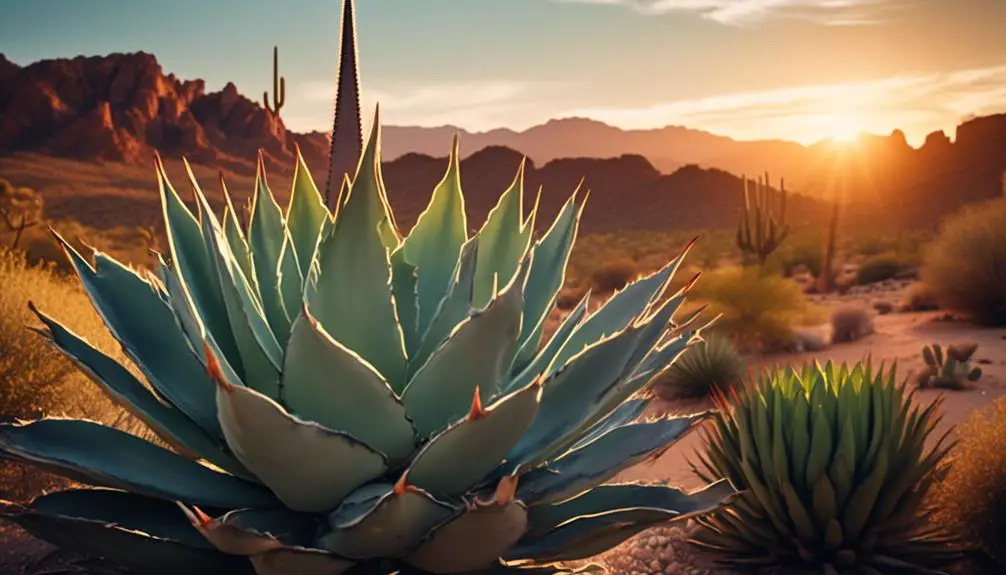
Now let’s shift our focus to the next edible plant in Arizona: Agave. Agave plants are a staple in the wild edible plants of Arizona, particularly in the Sonoran Desert. These plants have edible hearts that can be roasted and used as a sweetener or made into a syrup. The hearts of certain agave species aren’t only versatile but also highly nutritious, making them a valuable resource in the desert.
However, harvesting the hearts of agave plants requires careful preparation. The leaves of the agave plant are spiky, so it’s important to handle them with caution. Once the leaves are removed, the heart is ready to be harvested. It can be cooked by roasting it in a fire or oven, which brings out its natural sweetness.
Agave is a signature flavor in Arizona’s culinary scene, offering a unique culinary experience in the desert. The harvested hearts can be used in various dishes, adding a distinct taste to the cuisine. Additionally, agave nectar, derived from the plant, can be used as a natural sweetener in recipes like cookies, providing a healthier alternative to processed sugars.
Buckhorn Cholla
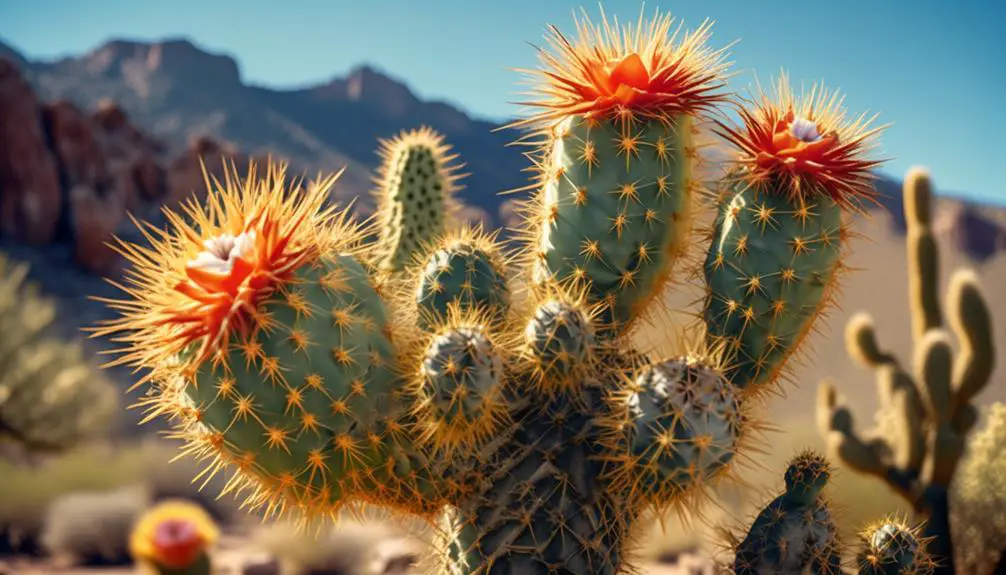
To explore another edible plant in Arizona, let’s turn our attention to Buckhorn Cholla. Buckhorn Cholla, also known as Cylindropuntia acanthocarpa, is a remarkable addition to desert foraging in the Sonoran Desert. This plant offers a unique taste and various edible parts.
The immature flower buds, ripened fruit, and young, non-woody joints of Buckhorn Cholla are all edible. However, caution must be exercised when harvesting this plant due to its thorns, which need to be removed before consuming. The fruit of Buckhorn Cholla has a sweet flavor and is mildly reminiscent of strawberries, making it a delightful surprise in the desert.
Not only can the fruit be enjoyed, but the joints of the jumping cholla, a type of Buckhorn Cholla, can also be eaten. These joints can be consumed raw, although cooked joints are less likely to cause gastrointestinal upset. They’ve a taste similar to that of kiwi, adding another interesting dimension to this desert plant.
Palo Verde Seeds
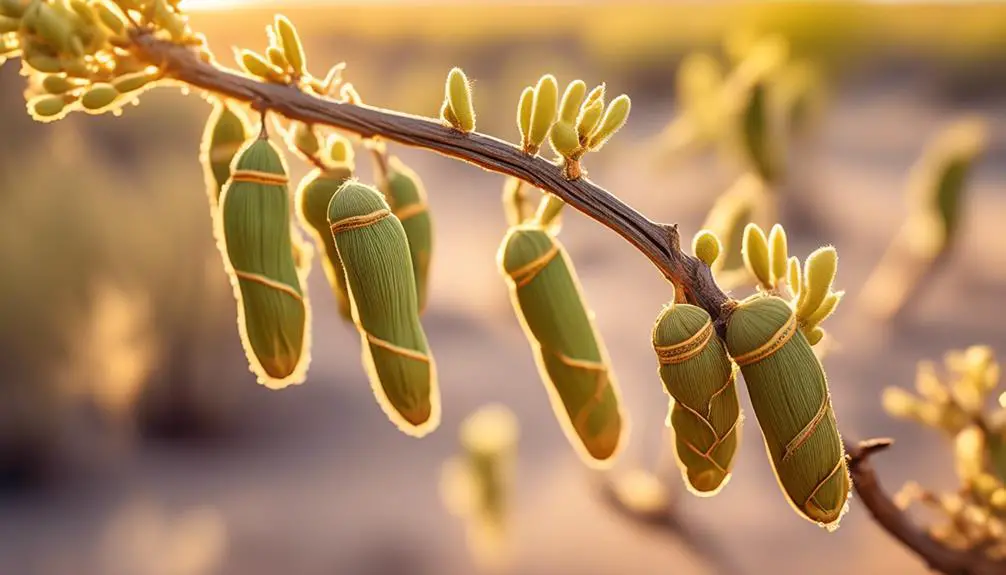
When exploring edible plants in Arizona, another fascinating option to consider is Palo Verde seeds, which offer a unique and nutritious addition to desert cooking. Palo Verde trees, commonly found in the Sonoran Desert, bear edible bean pods that are best consumed when soft and green, usually around April or early May. These beans, when harvested at the right time, taste similar to snap peas and provide a source of plant-based protein, making them a healthy choice for meals.
Foraging these beans from the trees in the desert can be a rewarding experience that allows you to incorporate a locally available and sustainable food source into your cooking.
To identify Palo Verde beans, look for the prickly pear cactus-like appearance of the tree’s bean pods. When the pods are young and tender, they can be easily opened to reveal the seeds inside. These seeds can be boiled, roasted, or ground into flour to be used in a variety of dishes, such as soups, stews, or even baked goods. Their mild and nutty flavor adds depth to your culinary creations, while their nutritional value enhances the overall healthiness of your meals.
When foraging for Palo Verde beans, it’s important to be mindful of the environment and to only harvest what you need. By doing so, you contribute to the sustainability of this unique desert food source.
Opuntia velutina

One versatile and nutritious plant commonly found in the Sonoran Desert is Opuntia velutina, also known as the Prickly Pear. This plant offers various edible parts that have been utilized by Native American tribes for centuries.
The pads, or nopales, of the Prickly Pear can be harvested and prepared in different ways. They can be boiled and served in a salad or as a vegetable side dish, providing a unique and tangy flavor.
Additionally, the fruit of Opuntia Velutina is another edible part that’s highly sought after. The red flesh of the fruit is sweet and can be consumed raw or cooked, although it’s recommended to avoid eating the skin. The fruit can also be used to make syrup, which is a popular flavoring in candy, lemonade, and margaritas.
When foraging for Prickly Pear, it’s important to handle the plant with care due to its prickly nature.
Cylindropuntia
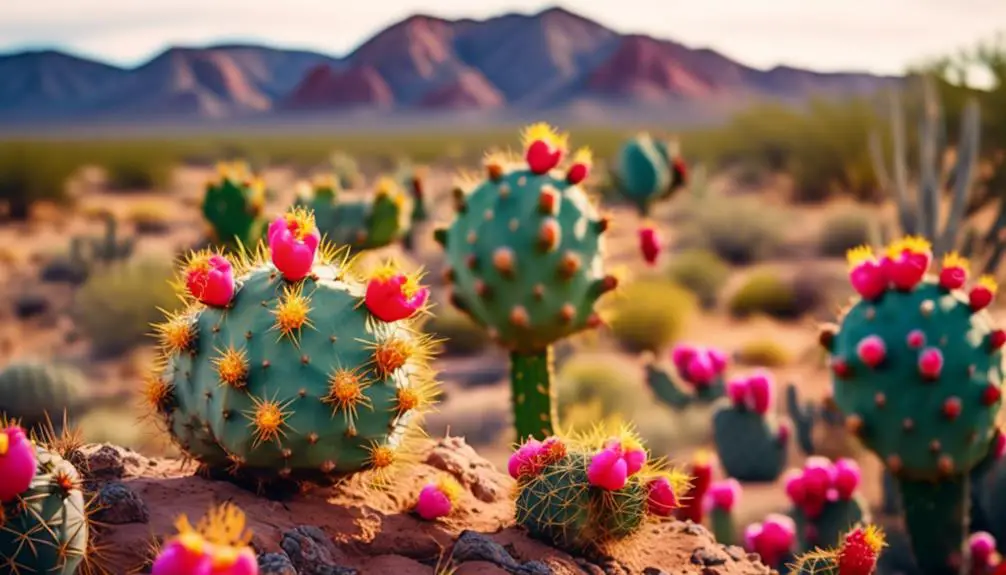
After exploring the versatile and nutritious Opuntia Velutina, let’s now turn our attention to another edible plant commonly found in the Sonoran Desert: Cylindropuntia, also known as Cholla.
Cylindropuntia has edible parts such as immature flower buds, ripened fruit, and young, non-woody joints. However, extreme care should be taken when harvesting Cylindropuntia as the thorns must be removed prior to eating.
The taste of Cylindropuntia fruit is sweet and mildly reminiscent of strawberries, making it a delightful treat. The joints of jumping cholla can be eaten raw, but it’s important to note that cooked cholla is less likely to cause gastrointestinal upset.
When considering Cylindropuntia as a wild edible plant, it’s crucial to remember that the thorns must be removed before consuming. The fruit has a kiwi-like taste, which adds a refreshing flavor to any dish.
Cylindropuntia, or Cholla, offers a variety of edible parts including fruit and flower buds, but caution and proper preparation are necessary due to its spiny nature. Enjoy these prickly pear delights straight from the Sonoran Desert!
Echinocactus grusonii

Echinocactus grusonii, also known as the golden barrel cactus, is an edible plant found in the desert regions of Arizona. This prickly pear, native to the Sonoran Desert, is widely recognized for its distinctive round shape and golden spines. While the Echinocactus grusonii isn’t as common as other edible desert plants like the prickly pear or the saguaro, it still offers a unique culinary experience.
The ripe fruit of the golden barrel cactus turns yellow, indicating its readiness for consumption. The flesh of the fruit is mildly tart and can be eaten raw or cooked. It’s important to note that the golden barrel cactus should only be eaten for its fruit; the rest of the plant isn’t edible. The seeds of the Echinocactus Grusonii are also valuable, as they provide a good source of protein and can be ground into a meal.
However, it’s crucial to exercise caution when consuming this cactus. Ingesting the flesh or juice can cause severe gastrointestinal symptoms. It’s important to remember that this cactus isn’t a source of water and should only be eaten in moderation and with proper preparation.
With its unique flavor and nutritional benefits, the golden barrel cactus offers a taste of the desert that’s worth exploring.

